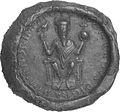Reichsadler
The Reichsadler (German pronunciation: [ˈra͜içs|aːdlɐ]; "Imperial Eagle") is the heraldic eagle, derived from the Roman eagle standard, used by the Holy Roman Emperors and in modern coats of arms of Germany, including those of the Second German Empire (1871–1918), the Weimar Republic (1919–1933) and Nazi Germany (1933–1945).
The same design has remained in use by the Federal Republic of Germany since 1950, albeit under the name Bundesadler ("Federal Eagle").
History
Holy Roman Empire
The Reichsadler, i. e. the German
An eagle statue was erected on the roof of the Carolingian palace, and an eagle was placed on the orb of
The Ottonian and Salian Emperors had themselves depicted with the Roman "eagle sceptre", and
An early depiction of a double-headed Imperial Eagle in a heraldic shield, attributed to
The Imperial Eagle also is depicted in the seals of
Use of the Imperial Eagle in the Imperial coat of arms of a reigning emperor dates to after the
The
Modern use
In 1804, Holy Roman Emperor Francis II established the Austrian Empire from the lands of the Habsburg monarchy, and adopted the double-headed eagle, aggrandized by an inescutcheon emblem of the House of Habsburg-Lorraine and the Order of the Golden Fleece, as its coat of arms; the Holy Roman Empire was subsequently dissolved in 1806. Since 1919 the coat of arms of Austria has depicted a single-headed eagle. Although not a national symbol in the modern sense, the Reichsadler evoked sentiments of loyalty to the empire.[2]
Following the
During Nazi rule, a stylised eagle combined with the Nazi swastika was made the national emblem (Hoheitszeichen) by order of Adolf Hitler in 1935. Despite its medieval origin, the term "Reichsadler" in common English understanding is mostly associated with this specific Nazi-era version. The Nazi Party had used a very similar symbol for itself, called the Parteiadler ("Party's eagle"). These two insignia can be distinguished as the Reichsadler looks to its right shoulder whereas the Parteiadler looks to its left shoulder.
After World War II the Federal Republic of Germany re-implemented the eagle used by the Weimar Republic by enactment of President Theodor Heuss in 1950.
Gallery
Holy Roman Empire
-
Seal of Conrad II (1029), with a depiction of the eagle-sceptre.
-
Imperial eagle on a coin of Frederick II (r. 1197–1250)
-
Arms ofChronica Maiora(ca. 1250), early depiction of a double-headed Reichsadler
-
Imperial coat of arms attributed to Henry VI (r. 1191–1197) from Codex Manesse (c. 1304).
-
Tomb ofCodex Balduini Trevirorum, c. 1340).
-
Imperial eagle in a seal used by Charles IV in 1349.
-
Double-headed imperial eagle in the seal used by Sigismund of Luxembourg in 1433
-
TheReichssturmfahne in a stained glass window in Bern Minster, ca. 1450.
-
Imperial coat of arms of Frederick III (r. 1452–1493) in the Wernigerode Armorial (ca. 1490)
-
Quaternion Eagle c. 1510, the eagle displaying the imperial quaternions on its remiges.
-
Imperial arms by Virgil Solis (ca. 1540)
-
Depiction of theReichssturmfahnein a 1545 woodcut
-
Imperial arms at theKoïfhus in Colmar(16th century)
-
The imperial eagle depicted with one, two and three heads (after Conrad Grünenberg 1483, copy of 1602/4)
-
Imperial arms of Mathias (r. 1612–1619) by Hans Ulrich Fisch (1627)
Modern history
-
Coat of arms of the short-livedGerman Empire (1848–49); the German Confederationused a similar eagle.
-
Coat of arms of the Austrian Empire (1804–1867); also used as the lesser arms of Austria-Hungary (1867–1915).
-
Reichsadler (official design 1888–1918) of the (Second) German Empire
-
Reichsadler (1919–1928) of the Weimar Republic
-
Parteiadler of the Nazi Party (1933–1945), with head looking to its left
-
Parteiadler of the Nazi Party (1933–1945), with head looking to its left, variant
-
Reichsadler (1935–1945) of Nazi Germany, with head looking to its right
-
Austrian coat of arms used during theaustrofascist Corporate State 1934–1938
-
Reichsadler (1928–1935) of the Weimar Republic and Bundesadler (1950–present) of the Federal Republic of Germany
-
"Bundesadler" of the Republic of Austria since 1945
-
The previous design, without the broken chains symbolizing the end of fascism, was used 1919–1934
See also
- Armorial of the Holy Roman Empire
- Quaternion Eagle
- Imperial Eagle beaker
- Aquila (Roman)
- Byzantine heraldry
- Coat of arms of Austria
- Coat of arms of Brandenburg
- Coat of arms of Germany
- Coat of arms of Prussia
- Coat of arms of Russia
- Double-headed eagle
- Coat of arms of Bogotá
References
- ^ ISBN 978-1440848568.
- ^ Selzer, Stephan. Deutsche Söldner im Italien des Trecento. Niemeyer: Tübingen, 2001. Page 167.
- Norbert Weyss: "Der Doppeladler – Geschichte eines Symbols", Adler 3, 1986, 78ff.
- Franz Gall: "Zur Entwicklung des Doppeladlers auf den kaiserlichen Siegeln", Adler 8 (1970), 281ff.
- Vladimir Monakhov: Новые-старые цвета России, или Как возвращали орла, ГЕРАЛЬДИКА СЕГОДНЯ (2003).
- Michael Göbl, "Staatssymbole des Habsburger-Reiches - ab 1867 mit besonderer Berücksichtigung des Staatswappens", in: Österreichs politische Symbole (1994), 11ff.
External links
- P. Diem, Die Entwicklung des österreichischen Doppeladlers (in German)




























